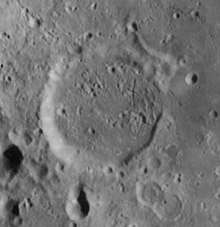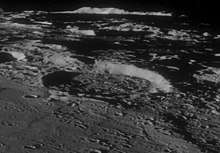Beaumont (crater)
Beaumont is a lava-flooded crater located on the southwestern shore of the Mare Nectaris on Earth's Moon. It lies to the northwest of the similarly flooded crater remnant Fracastorius. To the west is the prominent crater Catharina. The crater is named after French geologist Léonce Élie de Beaumont.[1]
 Lunar Orbiter 4 image | |
| Coordinates | 18.0°S 28.8°E |
|---|---|
| Diameter | 53 km |
| Depth | 1.7 km |
| Colongitude | 332° at sunrise |
| Eponym | L. É. de Beaumont |


The rim of Beaumont is breached in the east, where the lava from Mare Nectaris broached the crater and flooded the interior. Now only a worn and crater-impacted outer wall remains. If the crater once possessed a central peak, it is no longer apparent. The floor contains several hills and small craters. A low ridge runs northward from the crater rim across the Mare Nectaris.
Satellite craters
By convention these features are identified on lunar maps by placing the letter on the side of the crater midpoint that is closest to Beaumont.
| Beaumont | Latitude | Longitude | Diameter |
|---|---|---|---|
| A | 16.3° S | 27.7° E | 14 km |
| B | 18.6° S | 26.8° E | 16 km |
| C | 20.2° S | 28.0° E | 6 km |
| D | 17.0° S | 26.2° E | 11 km |
| E | 18.8° S | 27.5° E | 18 km |
| F | 18.3° S | 26.6° E | 10 km |
| G | 20.3° S | 27.1° E | 8 km |
| H | 17.2° S | 28.4° E | 6 km |
| J | 19.9° S | 26.5° E | 5 km |
| K | 17.5° S | 30.1° E | 6 km |
| L | 14.4° S | 30.0° E | 4 km |
| M | 19.4° S | 28.6° E | 10 km |
| N | 16.9° S | 27.7° E | 5 km |
| P | 19.9° S | 29.6° E | 17 km |
| R | 17.9° S | 30.7° E | 4 km |
 Beaumont D from Apollo 14
Beaumont D from Apollo 14 The small dark-halo crater Beaumont L, from Apollo 14
The small dark-halo crater Beaumont L, from Apollo 14
References
- "Beaumont (crater)". Gazetteer of Planetary Nomenclature. USGS Astrogeology Research Program.
- Andersson, L. E.; Whitaker, E. A. (1982). NASA Catalogue of Lunar Nomenclature. NASA RP-1097.CS1 maint: ref=harv (link)
- Bussey, B.; Spudis, P. (2004). The Clementine Atlas of the Moon. New York: Cambridge University Press. ISBN 978-0-521-81528-4.CS1 maint: ref=harv (link)
- Cocks, Elijah E.; Cocks, Josiah C. (1995). Who's Who on the Moon: A Biographical Dictionary of Lunar Nomenclature. Tudor Publishers. ISBN 978-0-936389-27-1.CS1 maint: ref=harv (link)
- McDowell, Jonathan (July 15, 2007). "Lunar Nomenclature". Jonathan's Space Report. Retrieved 2007-10-24.CS1 maint: ref=harv (link)
- Menzel, D. H.; Minnaert, M.; Levin, B.; Dollfus, A.; Bell, B. (1971). "Report on Lunar Nomenclature by the Working Group of Commission 17 of the IAU". Space Science Reviews. 12 (2): 136–186. Bibcode:1971SSRv...12..136M. doi:10.1007/BF00171763.CS1 maint: ref=harv (link)
- Moore, Patrick (2001). On the Moon. Sterling Publishing Co. ISBN 978-0-304-35469-6.CS1 maint: ref=harv (link)
- Price, Fred W. (1988). The Moon Observer's Handbook. Cambridge University Press. ISBN 978-0-521-33500-3.CS1 maint: ref=harv (link)
- Rükl, Antonín (1990). Atlas of the Moon. Kalmbach Books. ISBN 978-0-913135-17-4.CS1 maint: ref=harv (link)
- Webb, Rev. T. W. (1962). Celestial Objects for Common Telescopes (6th revised ed.). Dover. ISBN 978-0-486-20917-3.CS1 maint: ref=harv (link)
- Whitaker, Ewen A. (1999). Mapping and Naming the Moon. Cambridge University Press. ISBN 978-0-521-62248-6.CS1 maint: ref=harv (link)
- Wlasuk, Peter T. (2000). Observing the Moon. Springer. ISBN 978-1-85233-193-1.CS1 maint: ref=harv (link)
| Wikimedia Commons has media related to Beaumont (crater). |
